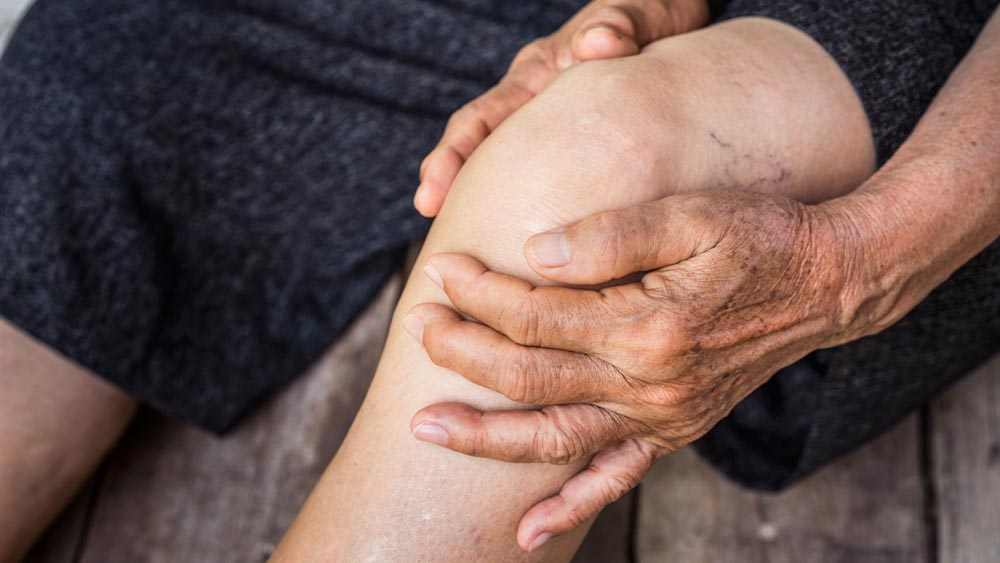Arthritis in the older senior citizens. Did you know that there are more than 100 types of arthritis and that one of them is the most common rheumatic disease? In the following article Nomenial investigates the main aspects of this condition so frequent in older people.
Arthritis in the older adults: What is arthritis?
Arthritis means, etymologically, inflammation of the joints. This inflammation affects the synovial membrane (the tissue that surrounds the cartilage that protects the bones). As a result, the joint can become weakened and deformed, which prevents its proper functioning and leads to functional inability to perform everyday tasks.
This damage can occur in any joint in the body, although certain types of arthritis tend to occur in specific areas. For example, rheumatoid arthritis mostly affects the upper extremities (wrists and knuckles) and the lower extremities (feet), while other types of arthritis usually affect the joints in the spine.
Difference between arthritis and osteoarthritis
Although some tend to confuse them, these are diseases with very different main characteristics:
Affected party. While in arthritis it is damaged, as we pointed out at the beginning of this text, the synovial membrane, in osteoarthritis it is the cartilages that are affected.
Symptoms. In both cases, the joint presents stiffness in the morning, but its persistence and pain is different. Whereas in the arthritis it is constant (even, intensifying in rest), in the arthritis the pain is aggravated with the movement and it is reduced with the rest.
Arthritis in the older adults: Types of arthritis
As indicated at the beginning of the text, arthritis includes more than 100 diseases and rheumatic conditions. Among all of them, the following types of arthritis should be noted:
Rheumatoid arthritis
It is the most common arthritis. To give it the importance it deserves, after this point we will give it individualized attention.
Osteoarthritis
Very frequent in older people, since it is produced by the aging itself. As a consequence of this, the joint cartilage wears out, causing pain, swelling and stiffness. If the cartilage is deteriorated completely, the bone will come to rub with the other bone with which it connects.
The parts of the body that this type of arthritis affects most often are the hands, knees, hips and lower back.
Psoriatic arthritis
About 10% of people with psoriasis may suffer, as a result of this, this type of arthritis. Psoriatic arthritis can affect any part of the body, from fingertips to the spine.
As for its persistence, patients alternate periods of strong outbreaks of the disease with times of remission.
The main symptoms are joint pain, stiffness and swelling and it presents a characteristic visual aspect: the skin of the affected joint is covered with red spots and silvery scales.
Gouty arthritis
It is produced when uric acid accumulates in excess in the blood, causing inflammation of the joints. Normally, it starts in the big toe and only affects one joint.
People with diabetes, kidney disease, obesity or anemia are more likely to have this type of arthritis.
Traumatic Arthritis
It occurs due to an injury or a blow as a result of excessive or improperly performed physical exercise. Also, a fractured joint can lead to this type of arthritis. For this reason, senior citizens must be careful when performing exercises that affect the joints, not over-exercising them if they are already damaged, and trying to lose weight to facilitate the function of the joints.
Septic arthritis
Also called bacterial or infectious arthritis. As its name suggests, it involves a painful infection of the joints. The infection can be caused by germs in the bloodstream, which move them from one part of the body to another, or it can be triggered by a penetrating injury, in which the germs enter the joint directly. This type of arthritis evolves very quickly and often leads to extreme discomfort.
Reactive arthritis
Although its specific cause is not yet known, it is known that it always happens after an infection (however, the joint that is affected is not infected, but the infection occurs elsewhere in the body).
Among the infections from which this type of arthritis can occur, those that arise as a result of food intolerance stand out.
Arthritis in the Senior Citizens: Rheumatoid arthritis
Rheumatoid arthritis is an autoimmune disease in which the body’s own defenses attack the lining of the joints. In this type of arthritis, inflammation in the joint lining in the bones causes damage to the joint, particularly the cartilage. It can also cause tingling in the hands from carpal tunnel syndrome.
More than 200,000 people in Spain suffer from rheumatoid arthritis, a figure largely made up of older people. So much is its prevalence that every year about 10,000-20,000 new cases are diagnosed.
At the same time, women are more likely to suffer from rheumatoid arthritis than men. Doctors estimate that this disease affects about 5% of women over 55 years (a group to which the disease would be about 5 / 10 times more frequent than in the general population).
Rheumatoid arthritis symptoms
The most common symptoms of arthritis are in the joints or in the area around them. The main symptoms are:
It is the most habitual initial symptom, appearing after the nocturnal rest.
Inflammation.
Swelling.
Problems to move the affected articulation.
Tiredness and muscle weakness.
Loss of appetite.
Likewise, there are usually extraarticular manifestations, which appear when the disease is already established. These mainly affect the skin, blood vessels, lungs and eyes.
The disorder evolves in a very different way according to the person it affects. Thus, people with rheumatoid arthritis can present:
Relatively mild symptoms.
Sporadic flare-ups and long periods of remission (when the disease is inactive).
Severe symptoms, which progress steadily, and development can be both slow and fast. This is the most frequent form of disease progression.
Arthritis in the hands of senior citizens
The hands are affected in 90% of people with rheumatoid arthritis and are usually the first parts of the body to experience symptoms of the disease.
The most common symptoms are morning stiffness (which does not usually go away until several hours after waking), pain (which is usually constant), and weakening of the muscles.
As the arthritis progresses, senior citizens begin to have difficulty flexing their fingers and performing other types of movements such as making a fist or moving their thumb, feeling intense pain when they try to perform them.
Arthritis in the feet of senior citizens
The joints of the feet are also affected in 90% of the people who suffer from rheumatoid arthritis, appearing already in the early stages.
The most characteristic symptom is the pain in the superior part of the foot, which is aggravated when supporting it, when walking or when a shoe of narrow width is put on.
Skeletal deformations tend to develop, so that the front of the foot widens, the big toe deviates outwards and the rest of the toes bend downwards.
Knee Arthritis in Senior Citizens
The knee is affected in 80% of the cases, being, like the hands and feet, the first joints to be damaged.
In the initial phases, the most habitual symptom is the pain and the inflammation of the knee.
Sometimes, unlike what usually happens in small joints, a joint effusion (an excessive accumulation of fluid inside the joint) can occur.
If it is not treated from the early stages, this condition can damage the ligaments and bones of the knee, causing irreversible deformations that can lead to a great loss of autonomy. In fact, knee injury is one of the main causes of disability for people with arthritis.
Rheumatoid arthritis treatment
An adequate treatment can alleviate the symptoms of arthritis and improve its prognosis, achieving an increase in the quality of life of those who suffer from it.
The most used treatments are:
Medication. They reduce inflammation and pain.
Therapy. Physical therapy and controlled physical exercise increase bone and muscle strength, making movement and flexibility easier.
Surgery. Called arthroplasty, this procedure reconstructs or replaces a damaged joint. The goal is to eliminate deep-seated pain and restoring joint function.
To these treatments we must add the one that involves all of them: constant attention. The advance of the disease causes the affected person to lose autonomy. It is essential to have a person on whom to rely so that their daily routine is as little affected as possible. It is at this point that the option of hiring a carer becomes their effective physical and emotional treatment.







